Page 525 -
P. 525
524 Part Four Building and Managing Systems
take one or two weeks and another trip to the bookstore for the customer.
If the customer lives far away from the bookstore, the time to travel to the
bookstore would have to be factored in. The bookstore will have to pay the
costs for maintaining a physical store and keeping the book in stock, for
sales staff on site, and for shipment costs if the book has to be obtained from
another location.
The new process for purchasing a book online might only take several
minutes, although the customer might have to wait several days or a week to
receive the book in the mail and will have to pay a shipping charge. But the
customer saves time and money by not having to travel to the bookstore or
make additional visits to pick up the book. Booksellers’ costs are lower
because they do not have to pay for a physical store location or for local
inventory.
4. Implement the new process: Once the new process has been thoroughly
modeled and analyzed, it must be translated into a new set of procedures
and work rules. New information systems or enhancements to existing
systems may have to be implemented to support the redesigned process.
The new process and supporting systems are rolled out into the business
organization. As the business starts using this process, problems are uncov-
ered and addressed. Employees working with the process may recommend
improvements.
5. Continuous measurement: Once a process has been implemented
and optimized, it needs to be continually measured. Why? Processes may
deteriorate over time as employees fall back on old methods, or they may
lose their effectiveness if the business experiences other changes.
Although many business process improvements are incremental and
ongoing, there are occasions when more radical change must take place. Our
example of a physical bookstore redesigning the book-purchasing process so
that it can be carried out online is an example of this type of radical, far-reach-
ing change. When properly implemented, business process redesign produces
dramatic gains in productivity and efficiency, and may even change the way
the business is run. In some instances, it drives a “paradigm shift” that
transforms the nature of the business itself.
This actually happened in book retailing when Amazon challenged traditional
physical bookstores with its online retail model. By radically rethinking the
way a book can be purchased and sold, Amazon and other online bookstores
have achieved remarkable efficiencies, cost reductions, and a whole new way
of doing business.
BPM poses challenges. Executives report that the largest single barrier to
successful business process change is organizational culture. Employees do not
like unfamiliar routines and often try to resist change. This is especially true of
projects where organizational changes are very ambitious and far-reaching.
Managing change is neither simple nor intuitive, and companies committed to
extensive process improvement need a good change management strategy (see
Chapter 14).
Tools for Business Process Management
Over 100 software firms provide tools for various aspects of BPM, including
IBM, Oracle, and TIBCO. These tools help businesses identify and document
processes requiring improvement, create models of improved processes,
capture and enforce business rules for performing processes, and integrate
existing systems to support new or redesigned processes. BPM software tools
MIS_13_Ch_13 global.indd 524 1/17/2013 2:31:22 PM

